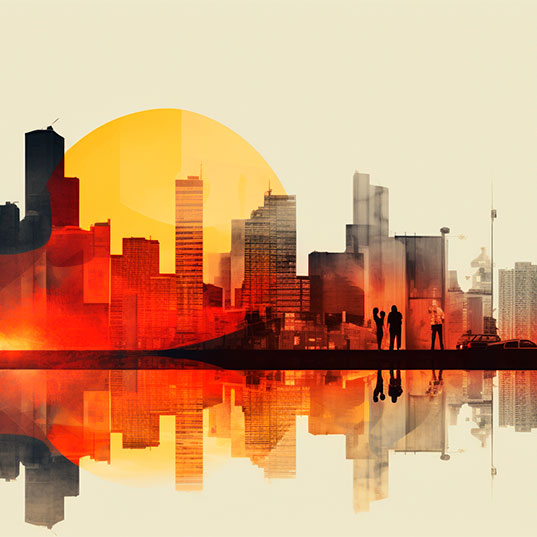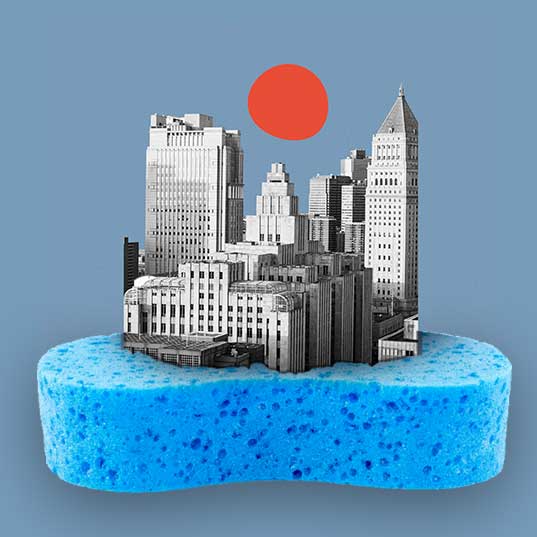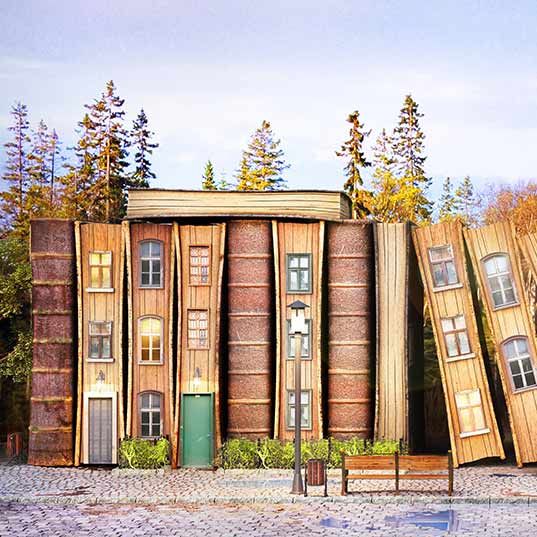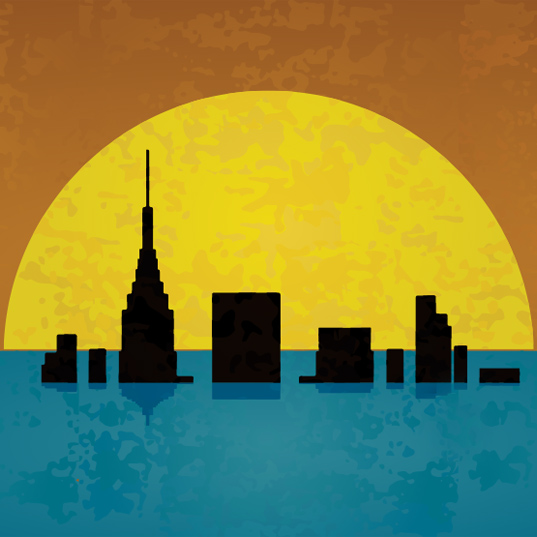From Paris to Singapore, cities adapt to cope with heatwaves
From roof gardens to urban shade policies, discover the promising measures cities are adopting to fight the heatwaves feared for 2024.
Athletes at the Olympic Games in Paris this summer will probably need to overcome an adversary they might not have counted upon: increasing global temperatures. We now know that last year Europe heated up twice as fast as the rest of the planet. Climate change is making Parisian summers so hot as to become dangerous. To avoid putting the athletes at risk, the French capital has already begun implementing some innovative measures.
And Paris is not the only city planning for the summer. Cities worldwide are introducing strategies to combat extreme heat and protect their residents. The danger from more intense and frequent heatwaves has driven local authority planners to rethink how our cities can adapt and respond to these climate challenges. Below, we look at some of the most promising measures cities are taking to adapt to heatwaves.
What will I learn from this article?
- Air conditioning systems
- Climate refuges
- Tree coverage
- Reflective paint
- Green building technology
- Apps to locate fountains
Innovative air conditioning systems
 During the most recent Summer Olympic Games held in Tokyo, the intense heat put the stamina of many athletes to the test, forcing them to the limits of their endurance and leading organizers to change the times of various competitions. With this in mind, Paris, home to this summer’s Games, is trying to avoid repeating history in the face of its own climate challenges.
During the most recent Summer Olympic Games held in Tokyo, the intense heat put the stamina of many athletes to the test, forcing them to the limits of their endurance and leading organizers to change the times of various competitions. With this in mind, Paris, home to this summer’s Games, is trying to avoid repeating history in the face of its own climate challenges.
The French capital is especially vulnerable to heatwaves, a problem exacerbated by its scarcity of green zones – barely 10 % of the city – and many buildings soaking up the heat due to zinc roofs.
In an effort to tackle these problems through sustainability, the Olympic village in Paris is making some important innovations. Its buildings’ roofs have been designed to foster biodiversity and low-carbon-emission construction materials are being used alongside the creation of green areas and a public park.
The athletes’ quarters will not be equipped with conventional air conditioning, but a cooling system combining natural ventilation with an innovative, underground water refrigeration solution. This geothermal energy system will keep the temperature of the Seine-Saint-Denis apartments below 27 degrees at night, including in the case of heatwaves, the organizers explain in this article. Combining this system with special insulation will also allow them to conserve night-time freshness during the day.
A climate refuge network for cities
In the face of global warming, a growing trend is the creation of climate refuges. At the beginning of 2024, coinciding with the year’s first heatwave in Santiago, the capital of Chile launched its Climate Refuge Network, places specially equipped to offer comfort, hydration and rest in the heat for travelers and residents alike.
A climate refuge is a natural or urban space that offers climatically-comfortable environmental conditions to protect people in unfavorable conditions. They enable escape from extreme heat, but also protect from cold and drought, among other circumstances. Parks and gardens, libraries, museums, schools and other public buildings, can be used as climate refuges.
According to a study published in the magazine Nature Climate Change, the climate crisis is responsible for 40% of deaths from heat. In Santiago, some 280 people a year die from this cause. Other cities, such as Buenos Aires and Barcelona, already have spaces to protect inhabitants.
Re-greening cities
Tree planting might not be the most innovative measure against heat in this list, but it is the most ancient. Its efficiency should not be underestimated. Trees don’t only offer shade, they are vital for the evapotranspiration process, through which they emit water vapor to the air, refreshing the surrounding environment. Trees also act as carbon sinks, absorbing carbon dioxide and as such reducing the greenhouse effect that contributes to global warming.
A study published recently in The Lancet, containing data from 93 European towns and cities (where 57 million people over 20 years of age live), estimates that around 6,700 people died prematurely due to extreme heat, a third of whom could have survived if trees had been planted in 30% of urban areas.
This age-old practice of planting trees has been revalidated in recent years by cities seeking solutions to combat urban heat islands and improve their residents’ lives. Urban reforestation initiatives don’t only focus on planting native species to restore ecosystems, but also creating green spaces to foster biodiversity, offer refuge and feed local fauna.
Reflective paint
The city of Los Angeles has spent the last few years painting the asphalt in its streets light grey. Surrounded by desert and covered with thousands of kilometers of asphalt, the Californian city is a classic example of urban heat island effect, a phenomenon we studied in this article.
To tackle the phenomenon, they are covering the surfaces of the streets with a special kind of paint that can reflect a significant quantity of solar radiation instead of absorbing it like traditional asphalt. The key feature of this paint is its “albedo” or ability to reflect sunlight. While dark surfaces have a low albedo and absorb more heat, those treated with reflective paint have a high albedo and can reflect a large part of the incoming solar energy.
Green building technology
 In the noisy streets of Singapore, a green transformation is taking place and it’s not just an aesthetic question. Nature is reclaiming its place at the heart of our cities through roof and wall gardens. The movement toward green infrastructure is doing much more than add a touch of color to our urban landscapes, it is tackling head on the environmental challenge of urban heat islands.
In the noisy streets of Singapore, a green transformation is taking place and it’s not just an aesthetic question. Nature is reclaiming its place at the heart of our cities through roof and wall gardens. The movement toward green infrastructure is doing much more than add a touch of color to our urban landscapes, it is tackling head on the environmental challenge of urban heat islands.
One of the most prominent symbols of this green architecture is the CapitaSpring tower, one of the highest skyscrapers in Singapore, built using the principles of biophilic architecture. With vertical gardens extending the length of its faces and a park on the roof, this building is testimony to how urban spaces can coexist with nature, fostering a healthier and more sustainable environment for their residents.
As well as providing a natural barrier against heat, these green urban spaces play a vital role in reducing energy demand. By keeping the buildings cool, they reduce the need for air conditioning, meanwhile reducing greenhouse gas emissions. The story doesn’t end here, though. The vegetation favors evaporation and transpiration, natural processes which refresh the surrounding air, improving quality of life for all the city’s inhabitants.
Water for drinking and cooling down
Water is undoubtedly one of our greatest allies against high temperatures. So, public fountains are in this sense a key element in cities for assuring safe, free access to water for those strolling through their streets.
Some of the climate change adaptation measures consist of recovering traditional ideas, like public fountains, and mobile apps have been launched to locate them. Barcelona, for example, has put an app at the disposition of its citizens to consult the location of some 1,714 drinking water sources in the city.
To conclude, against the growing threat of extreme heatwaves cities are demonstrating the capacity to adapt, and resilience. Through innovation, green urban planning and community cooperation, measures don’t only seek to offer instant relief, but also to prepare our towns and cities for a more sustainable and habitable future. This summer could prove to be an inflection in our relation with the urban climate, leading the way toward fresher, greener and pleasanter cities.







